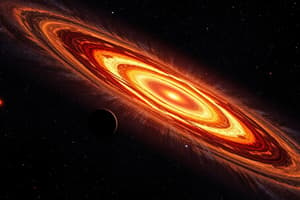Podcast
Questions and Answers
What explanation did Emanuel Swedenborg, Immanuel Kant, and Pierre-Simon Laplace provide regarding the formation of the solar system?
What explanation did Emanuel Swedenborg, Immanuel Kant, and Pierre-Simon Laplace provide regarding the formation of the solar system?
- Formation through a series of collisions.
- A model based on solid celestial bodies.
- A theory based on a static universe.
- A rotating gaseous cloud theory. (correct)
Which part of the nebular theory describes the formation of the sun?
Which part of the nebular theory describes the formation of the sun?
- The sun forms in the middle of a cooling and contracting cloud. (correct)
- The sun develops from the outer reaches of the cloud.
- The sun is created from planet collisions.
- The sun forms from a solid core.
What was a significant limitation of the nebular theory proposed by Swedenborg, Kant, and Laplace?
What was a significant limitation of the nebular theory proposed by Swedenborg, Kant, and Laplace?
- It ignored the concept of gravity entirely.
- It failed to explain the size of the sun.
- It did not account for angular momentum distribution. (correct)
- It suggested planets formed before the sun.
In what century did Emanuel Swedenborg, Immanuel Kant, and Pierre-Simon Laplace develop their ideas about the solar system's formation?
In what century did Emanuel Swedenborg, Immanuel Kant, and Pierre-Simon Laplace develop their ideas about the solar system's formation?
Which statement best describes the conceptualization of the planets in the nebular theory?
Which statement best describes the conceptualization of the planets in the nebular theory?
Flashcards are hidden until you start studying
Study Notes
Nebular Theory and Key Thinkers
- Emanuel Swedenborg, Immanuel Kant, and Pierre-Simon Laplace developed the concept of a rotating gaseous cloud in the 1700s.
- This cloud cools and contracts, forming the sun at its center while the remaining material forms a disc that evolves into planets.
- The theory was significant in shaping early understanding of solar system formation.
Limitations of Nebular Theory
- The nebular theory does not explain the observed distribution of angular momentum within the solar system.
- Angular momentum is crucial for understanding orbits of planets and their relative motions.
- This gap in the theory highlighted the need for further investigation into solar system dynamics.
Studying That Suits You
Use AI to generate personalized quizzes and flashcards to suit your learning preferences.





